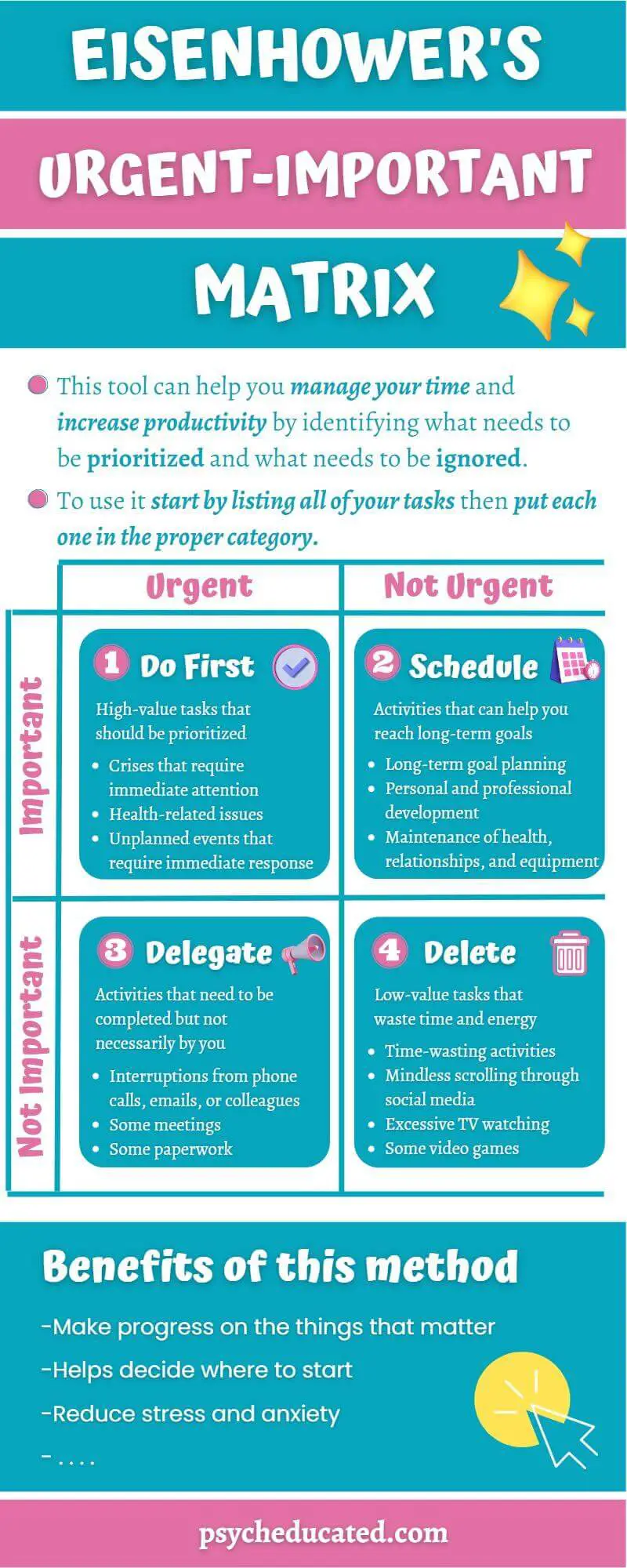Find us on:
Urgent-Important Matrix: How To Master Prioritization and Time Management

Do you ever feel stressed and overwhelmed looking at that long to-do list? Do you struggle to manage your time, prioritize tasks, and be productive? How do you handle deadlines, urgent requests, and important work?
Well, the Urgent Important Matrix can help with all of the above. By categorizing tasks based on their importance and urgency, this fantastic tool enables you to focus on what matters most and make progress toward your goals more efficiently.
In this article, we’ll learn all about the Urgent Important Matrix and how you can use it to master time management and prioritization.
What’s the Urgent-Important Matrix
The Urgent Important Matrix is a powerful time management tool that can help you maximize your productivity by prioritizing tasks based on importance and urgency.
It’s also known as the Eisenhower Matrix or the Eisenhower Box, named after Dwight D. Eisenhower, the 34th President of the United States.
Eisenhower was known for his many accomplishments and for his exceptional time management skills. He knew exactly how to deal with the urgent and important dilemma.
In a 1954 speech, Eisenhower quoted a university president who said:
I have two kinds of problems: urgent and important. The urgent are not important, and the important are never urgent.
This quote explains the philosophy behind the creation of the Urgent-Important Matrix.
While many people may prioritize urgent tasks as the most pressing on their to-do list, this approach may not always be the most effective. In fact, focusing solely on urgent tasks can lead to neglecting important tasks that may require more time and attention. Therefore, it’s essential to carefully consider the urgency and importance of each task and prioritize accordingly.
It was Stephen Covey who popularized the Eisenhower Matrix as a tool for time management and productivity in his bestselling book “The 7 Habits of Highly Effective People.”
If you often feel like you are spending your day reacting to urgent issues, don’t feel like your work is making a significant impact, or have important long-term goals that you are unable to make progress on, then it may be worth trying out the Eisenhower Matrix.
Understanding what’s urgent and what’s important?
Before explaining the components of the matrix, it’s important to distinguish between urgent and important tasks to know what to focus on.
However, our brains find it hard to prioritize what will serve them the most and figure out what’s important for their goals because of the Mere Urgency Effect.
According to a recent study, people tend to prioritize urgency over importance when deciding what tasks to focus on.
people are more likely to perform unimportant tasks over important tasks that are clearly dominating in terms of payoffs, when the unimportant tasks are merely characterized by spurious urgency.
Meng Zhu, Yang Yang, Christopher K Hsee
This means that the urgency of a task can make us ignore the degree of its importance.
This is something we need to be more conscious of when trying to classify urgent and important tasks in order to succeed at prioritizing rather than falling into the trap of the Mere Urgency Effect.
What are urgent tasks?
Urgent tasks are those that require immediate attention and action. They are time-sensitive and have a deadline that is rapidly approaching or has already passed.
Urgent tasks are often associated with high levels of stress and pressure, and failure to complete them on time may result in negative consequences.
The problem is that many of them can be unimportant and insignificant to your future plans.
What are important tasks?
Important tasks, on the other hand, are those that are crucial to achieving your long-term goals or objectives.
They may not have an immediate deadline or require immediate attention, but they are essential to your personal or professional growth and success.
These are the ones we usually procrastinate on.
⇨ Therefore, it is important to prioritize tasks based on both their level of urgency and importance.
This can help you manage your time effectively and ensure that you are making progress toward your goals.
The four quadrants of the matrix will help with that.
The four quadrants of the Urgent-Important time management tool

The matrix is based on the idea that tasks can be classified into four categories based on their urgency and importance.
The tasks will be divided into four quadrants:
Quadrant 1: Urgent / Important
These are the tasks that you’ll do first.
Examples:
- Deadline-driven work
- Emergency situations
- Crises that require immediate attention
- Health-related issues
- Unplanned events that require your immediate response
Quadrant 2: Not Urgent / Important
These tasks are the ones you’re going to schedule for later.
Examples:
- Long-term goal planning
- Personal and professional development
- Relationship building
- Strategic planning
- Proactive maintenance of health, relationships, and equipment
Quadrant 3: Urgent / Not Important
Here is everything you’re going to delegate to someone who can do it for you, or just avoid and push back.
Examples:
- Interruptions from phone calls, emails, or colleagues
- Some meetings
- Social media notifications
- Some email replies
- Some paperwork
Quadrant 4: Not Urgent / Not Important
The tasks in this box need to be deleted completely.
Examples:
- Time-wasting activities
- Mindless scrolling through social media
- Excessive TV watching
- Some video games
- Some online browsing
How to use the Urgent Important Matrix for time management
1. Identify all tasks and their deadlines
Make a list of all the tasks and projects you believe you must complete.
Try to include everything that occupies your time at work, no matter how small it may seem.
Set a deadline for every task that has one.
2. Categorize tasks into the four quadrants
Classify each task into one of the four quadrants of the Eisenhower matrix.
Use everything we have explained above to distinguish between urgent and important tasks and then categorize each one into the right box.
3. Prioritize tasks within each quadrant
You can now prioritize your tasks within each quadrant if there are many so that you don’t waste more time later deciding what task to begin with.
Tips for successful implementation of the Urgent Important Matrix

Identify your goals
Before you start categorizing your tasks into the urgent-important matrix, grab your notebook and write down your goals in specific detail. It’s very important to have a clear understanding of what you aspire to accomplish.
This will help you prioritize tasks that are aligned with your objectives and avoid filling your time with less important activities.
Avoid spending too much time on Quadrant 1 tasks
It’s important to be mindful of how much time we spend on Quadrant 1 tasks doing last-minute activities that we can’t ignore, as it can cause us to feel stressed, burnt out, and like we don’t have control over our days.
It’s easy to get caught up in this kind of activity all day, but this can drain our energy and passion for our work, and may lead us to escape into Quadrant 4 activities that are just a waste of our time.
If this quadrant is always filled, you should consider thinking about the strategies you’re adopting and the resources you have.
Avoid procrastinating on Quadrant 2 tasks
These tasks may not be urgent, but they are important, and investing time and energy into them can lead to significant personal and professional growth.
People tend to procrastinate on these important tasks because they don’t have a sense of urgency or immediate consequences. They would rather spend all their time responding to urgent emails from their clients instead of working on their personal development goals for example.
The key to making progress toward your objectives is to give them attention at the appropriate time and not wait until they become urgent. You don’t want too many tasks on your first quadrant because you’ll spend your day racing time. This means more stress and anxiety.
Ideally, you should spend most of your time in Quadrant 2.
If you struggle with procrastination, I think you might like this article: [How To Stop And Vanquish Procrastination? 9 Simple Tips]
Beware of the unproductive busywork in Quadrant 3
Tasks in the third quadrant like responding to upcoming phone calls, or being constantly interrupted by colleagues and notifications can give us the impression that we are busy when in fact we are not productive.
These tasks can consume a lot of our time without having a real impact on our goals. That’s why it’s recommended to push back on these tasks or delegate what can be delegated. Additionally, it’s important to refuse requests that are not aligned with our priorities. Basically, avoid doing things that don’t meet the importance requirement.
Instead, focus on the activities that really matter. The ones in the first two quadrants.
Review and adjust as needed
Take time to review and adjust your goals and priorities as needed.
This will help you stay on track and ensure that you are making progress toward your goals. Reviewing your progress and priorities allows you to identify any tasks that may have shifted from one quadrant to another or are no longer relevant.
This is also an opportunity to celebrate your accomplishments and identify areas where you can improve.
Benefits of the Urgent-Important Matrix
Here are some ways that you can benefit from using the Urgent-Important Matrix:
Helps decide where to start
Deciding where to start can be more exhausting than the work itself, but with the urgent important matrix, it can be very easy.
You just start with the first task in quadrant 1, and once you’re done with those you go to the most important task in quadrant 2, and so on.
Better time management
Focusing on important tasks allows you to manage your time more effectively and avoid getting bogged down in urgent but unimportant tasks.
Master prioritization
The matrix allows you to prioritize tasks based on their importance and urgency, which helps you focus on the tasks that have the biggest impact on your goals.
Reduce stress and anxiety
By identifying and focusing on important tasks, you can reduce stress and feel more in control of your workload.
Move closer to your goals
The matrix can help you identify and focus on tasks that are aligned with your goals, which can help you achieve them more quickly and efficiently. This tool will help you make progress on what really matters
Improve productivity
Focusing on high-value tasks will improve your productivity. You won’t be randomly working and filling out your time, instead, you’ll be making real progress with the activities that have the most impact.
Increase focus and motivation
The urgent-important matrix will help you stay focused on important tasks that contribute to your goals and eliminate non-important tasks that can be a distraction.
By regularly evaluating progress and making adjustments as necessary you’ll stay focused and motivated to see progress and achieve your goals.
Final thoughts
You can master time management and make progress on what really matters by using the Urgent-Important Matrix. It will help you work in a more strategic way, instead of just reacting to things that come up.
You can use the urgent-important matrix to manage your daily to-do list, your weekly activities, or what you have to do during the entire month. It depends on you, your workload, and how you prefer to organize yourself. Either way, I recommend you give it a try next time you’re writing your to-do list.
Even if you don’t draw the four boxes creating the known Eisenhower diagram, plan your work, prioritize your tasks using the urgent-important principle, and then execute accordingly.
This will really improve your productivity and time management abilities.
Don’t forget to save this Infographic of the Urgent-Important Matrix to your time management or productivity board on Pinterest!

Check out this article for more productivity tips:
How To Get Things Done Effectively: 13 Tips To Increase Productivity




